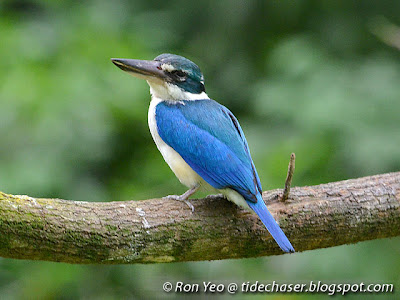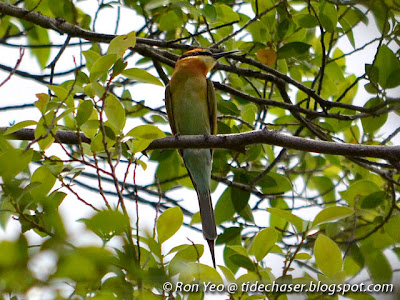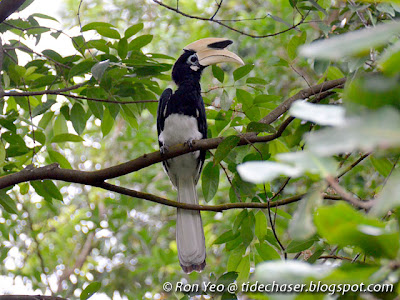Coraciiform birds (phylum Chordata, subphylum Vertebrata, superclass Tetrapoda, class Aves, order Coraciiformes) are mostly colourful birds which nest in holes. Many species have three forward-pointing toes, with two of the toes fused at the base.
Traditionally, they include the rollers, bee-eaters, kingfishers, hornbills and hoopoes, but there have been a number of disputes on the classification of the birds of this order, with studies proposing that the hornbills, hoopoes and kingfishers should become orders of their own.
Here are some of the coraciiform birds that can be found in Singapore:
Family Coraciidae
Members of this family are called rollers for their acrobatic style of flying. They usually have colourful plumage.

The Oriental Dollarbird (Eurystomus orientalis) gets its common name from a big white spot under each wing, which resembles a dollar coin with some imagination. It has a greenish-blue plumage and a dark orange beak. It is usually seen perching on tall trees at terrestrial forest edges, coastal forests and rural areas. It feeds on small insects and vertebrates. It gets to about 30cm long.
Family Alcedinidae
This family comprises the kingfishers, which are known for their excellent fishing abilities, though they also feed on other small animals. They are mostly colourful birds with a thick bill.

The Collared Kingfisher (Todirhamphus chloris) is one of the commonest kingfishers found in Singapore. The head and back is blue, while the neck and underside is white. The adults can get to about 25cm long. It can be seen in mangrove and coastal forests, along rivers and canals, and around inland water bodies. This kingfisher feeds on small animals, including insects, fish, reptiles and amphibians.

The White-throated Kingfisher (Halcyon smyrnensis) is also commonly seen in Singapore. It has a white throat, brown head, brown underside, and the back is mostly blue. It can get to almost 30cm long, and is found in parks, coastal forests, mangroves and near water bodies. It feeds on fish and other small animals.

The Stork-billed Kingfisher (Pelargopsis capensis) is the largest kingfisher in Singapore, reaching lengths of more than 35cm. It has a red bill, orange head and body, and blue back, wings and tail. It can be found near rivers and other water bodies, and in mangrove and coastal forests. This kingfisher feeds on small vertebrates and crustaceans.

The Blue-eared Kingfisher (Alcedo meninting) is a rare resident kingfisher. It has a rich blue head, back and wings, while the underside is brownish orange. It can get to about 15cm long, and is usually found near streams and ponds. It feeds mainly on fish.

The Common Kingfisher (Alcedo atthis) is a migrant which looks very similar to the previous species, but has a more turquoise/cyan head, back and wings. The underside is mostly brownish orange. It can grow to almost 20cm long, and is usually seen towards the end of the year and the beginning of the year near rivers and ponds. It feeds mostly on fish and small invertebrates.

The Ruddy Kingfisher (Halcyon coromanda) is a rare resident on Pulau Tekong, and hence the ones seen on mainland Singapore are mostly migrants. It has a red bill and a mostly reddish or brownish plumage. This kingfisher grows to about 25cm, and feeds on fish and other small animals. It is mostly seen in the forest.
Family Meropidae
This family comprises the bee-eaters, which get their common name from their diet, which include bees and other insects. The bee-eaters are generally colourful birds, and catch their prey on the wing.

The Blue-throated Bee-eater (Merops viridis) is a common migrant with a mostly greenish plumage, a blue throat, brown head, and blue tail. It is found in open areas and forest edges. Growing to over 25cm long, it hunts insects on the wing.

The Blue-tailed Bee-eater (Merops philippinus) is another common migrant seen in open areas and forest edges. It has a brownish-orange head and throat, greenish back and blue tail. The adults can reach lengths of about 30cm. This bee-eater feeds on insects, and sometimes, fish.
Family Bucerotidae
This family consists of the hornbills, which are generally big birds with a large bill. Many of the species have a horn-like or bump-like structure on top of the bill. Most hornbills nest in holes in tree trunks, with the females being sealed inside until the young birds are ready to fledge. During this period, the males will bring food for the female. All native hornbills were previously extinct in Singapore. However, the Oriental Pied Hornbill has successfully re-established itself in the country.

The Oriental Pied Hornbill (Anthracoceros albirostris) was previously extinct in Singapore, but a population which flew across from Johor, Malaysia, managed to re-establish themselves on Pulau Ubin in the late 1990s. They started breeding and eventually spread to Changi as well. The National Parks Board has started a successful breeding programme by installing many nest boxes for the hornbills to nest in. Several pairs of hornbills were released in various parts of Singapore, but unfortunately without much research done on the feasibility and possible impact on the ecosystem. This huge bird can reach a length of 90cm. While they feed mostly on fruits, especially figs, they have been observed to feed on small animals as well. This species is mostly found in wooded areas and forest edges. The males, as shown in the above photo, have a prominent, horn-like structure on the yellowish bill. The plumage is mostly black, except for the belly and lower tail feathers.

The female has a bump-like structure on its bill, without the pointy, horn-like extension.

The Rhinoceros Hornbill (Buceros rhinoceros) is extinct in Singapore, but escapees have seen.The above photo was taken in Malaysia.
Family Upupidae
This family comprises only one species, which has a distinctive, orangy crest with black bars. It is believed to be an introduced species.

The Hoopoe (Upupa epops) is sometimes seen in Singapore, and the ones seen are believed to be escapees. It gets its name from its call, which goes like "oop-oop-oop". It has black bars on its crest and back. The above photo was taken in Bhutan.
References
Traditionally, they include the rollers, bee-eaters, kingfishers, hornbills and hoopoes, but there have been a number of disputes on the classification of the birds of this order, with studies proposing that the hornbills, hoopoes and kingfishers should become orders of their own.
Here are some of the coraciiform birds that can be found in Singapore:
Family Coraciidae
Members of this family are called rollers for their acrobatic style of flying. They usually have colourful plumage.

The Oriental Dollarbird (Eurystomus orientalis) gets its common name from a big white spot under each wing, which resembles a dollar coin with some imagination. It has a greenish-blue plumage and a dark orange beak. It is usually seen perching on tall trees at terrestrial forest edges, coastal forests and rural areas. It feeds on small insects and vertebrates. It gets to about 30cm long.
Family Alcedinidae
This family comprises the kingfishers, which are known for their excellent fishing abilities, though they also feed on other small animals. They are mostly colourful birds with a thick bill.

The Collared Kingfisher (Todirhamphus chloris) is one of the commonest kingfishers found in Singapore. The head and back is blue, while the neck and underside is white. The adults can get to about 25cm long. It can be seen in mangrove and coastal forests, along rivers and canals, and around inland water bodies. This kingfisher feeds on small animals, including insects, fish, reptiles and amphibians.

The White-throated Kingfisher (Halcyon smyrnensis) is also commonly seen in Singapore. It has a white throat, brown head, brown underside, and the back is mostly blue. It can get to almost 30cm long, and is found in parks, coastal forests, mangroves and near water bodies. It feeds on fish and other small animals.

The Stork-billed Kingfisher (Pelargopsis capensis) is the largest kingfisher in Singapore, reaching lengths of more than 35cm. It has a red bill, orange head and body, and blue back, wings and tail. It can be found near rivers and other water bodies, and in mangrove and coastal forests. This kingfisher feeds on small vertebrates and crustaceans.

The Blue-eared Kingfisher (Alcedo meninting) is a rare resident kingfisher. It has a rich blue head, back and wings, while the underside is brownish orange. It can get to about 15cm long, and is usually found near streams and ponds. It feeds mainly on fish.

The Common Kingfisher (Alcedo atthis) is a migrant which looks very similar to the previous species, but has a more turquoise/cyan head, back and wings. The underside is mostly brownish orange. It can grow to almost 20cm long, and is usually seen towards the end of the year and the beginning of the year near rivers and ponds. It feeds mostly on fish and small invertebrates.

The Ruddy Kingfisher (Halcyon coromanda) is a rare resident on Pulau Tekong, and hence the ones seen on mainland Singapore are mostly migrants. It has a red bill and a mostly reddish or brownish plumage. This kingfisher grows to about 25cm, and feeds on fish and other small animals. It is mostly seen in the forest.
Family Meropidae
This family comprises the bee-eaters, which get their common name from their diet, which include bees and other insects. The bee-eaters are generally colourful birds, and catch their prey on the wing.

The Blue-throated Bee-eater (Merops viridis) is a common migrant with a mostly greenish plumage, a blue throat, brown head, and blue tail. It is found in open areas and forest edges. Growing to over 25cm long, it hunts insects on the wing.

The Blue-tailed Bee-eater (Merops philippinus) is another common migrant seen in open areas and forest edges. It has a brownish-orange head and throat, greenish back and blue tail. The adults can reach lengths of about 30cm. This bee-eater feeds on insects, and sometimes, fish.
Family Bucerotidae
This family consists of the hornbills, which are generally big birds with a large bill. Many of the species have a horn-like or bump-like structure on top of the bill. Most hornbills nest in holes in tree trunks, with the females being sealed inside until the young birds are ready to fledge. During this period, the males will bring food for the female. All native hornbills were previously extinct in Singapore. However, the Oriental Pied Hornbill has successfully re-established itself in the country.

The Oriental Pied Hornbill (Anthracoceros albirostris) was previously extinct in Singapore, but a population which flew across from Johor, Malaysia, managed to re-establish themselves on Pulau Ubin in the late 1990s. They started breeding and eventually spread to Changi as well. The National Parks Board has started a successful breeding programme by installing many nest boxes for the hornbills to nest in. Several pairs of hornbills were released in various parts of Singapore, but unfortunately without much research done on the feasibility and possible impact on the ecosystem. This huge bird can reach a length of 90cm. While they feed mostly on fruits, especially figs, they have been observed to feed on small animals as well. This species is mostly found in wooded areas and forest edges. The males, as shown in the above photo, have a prominent, horn-like structure on the yellowish bill. The plumage is mostly black, except for the belly and lower tail feathers.

The female has a bump-like structure on its bill, without the pointy, horn-like extension.

The Rhinoceros Hornbill (Buceros rhinoceros) is extinct in Singapore, but escapees have seen.The above photo was taken in Malaysia.
Family Upupidae
This family comprises only one species, which has a distinctive, orangy crest with black bars. It is believed to be an introduced species.

The Hoopoe (Upupa epops) is sometimes seen in Singapore, and the ones seen are believed to be escapees. It gets its name from its call, which goes like "oop-oop-oop". It has black bars on its crest and back. The above photo was taken in Bhutan.
References
- Briffett, C. 1986. A guide to the common birds of Singapore. Singapore Science Centre. 160 pp.
- Robson, C. 2010. New Holland field guide to the birds of South-East Asia. London: New Holland Publishers. 304 pp.
- Santana, E. 2009. "Kingfishers, Rollers, Hornbills etc" (OnLine) UntamedScience. Accessed Mar 18, 2013 at http://www.untamedscience.com/biodiversity/animals/chordates/birds/kingfishers-rollers-hornbills-etc
- Singapore Birds. Retrieved Mar 8, 2013, http://singaporebirds.blogspot.sg
- Strange, M. 2000. Photographic guide to the birds of Southeast Asia. Singapore: Periplus. 398 pp.

No comments:
Post a Comment